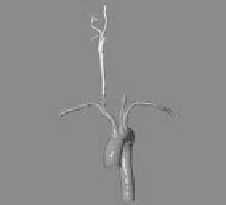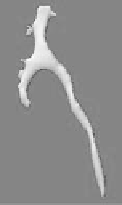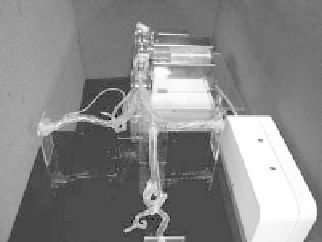Biomedical Engineering Reference
In-Depth Information
vasculature and ureter silicone model. Arch of aorta was represented
in the region 1 of the model; this region was used for speed control
experiments and preliminary experiments with the feedback system.
Sub-clavian arteries and a segment of common carotids near aorta
arch were represented by region 2 of the model; this region was
used for a two-dimensional path reconstruction experiment and
the speed control experiment. A ureter silicone membranous model
was used for a one-dimensional path reconstruction experiment. A
segment of a common carotid was represented by region 3 of the
model and was used for path reconstruction experiments. The ACIS
was evaluated inside two types of silicone arterial models, block
and membranous. Those silicone models were built using CT data
of human arteries and ureter, allowing a simulation of endovascular
or urological catheter insertion inside silicone models. The shape
Axial
View
Sagital
View
Axial
View
Common
Carotid
Full Body
Arterial
Model
Subclavia
Regions Used for
Experimentation
Aorta
Region 1
Region 2
Region 3
a)
b)
Figure 7.11
(a) CT data of vasculature used for the vasculature models
construction, highlighted arteries are the regions where ACIS
is evaluated. (b) CT data of ureter used for the silicone model
construction.
a)
b)
LSM
Arterial
Silicone
Model
Magnetic
Tracker
Transmitter
50 mm
c)
Catheter
50 m
m
40 mm
Figure 7.12
(a) Catheter shaped Magnetic Tracker receiver introduced
by LSM in silicone membranous model of regions 2 and
3. (b) Silicone block model of regions 1 and 2. (c) Silicone
membranous model of regions 1 and 2.












































































Search WWH ::

Custom Search